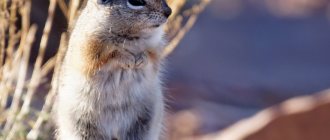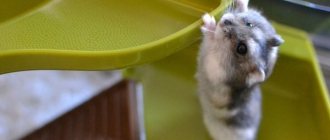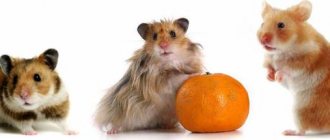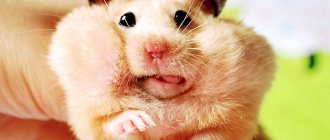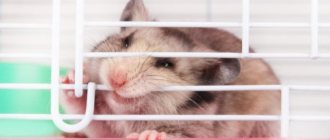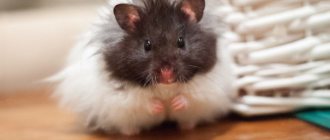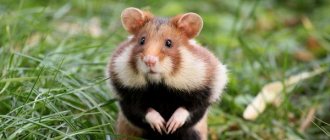And it looks like a funny animal... The carbysh differs from the domestic hamster in its size and character. Moreover, his character is not for the better. Wild hamsters are very aggressive. Watching the video, the thought arises that they completely lack a sense of fear and the instinct of self-preservation. Take a look for yourself:
In addition to the “standard” coloring, which you see in the photo in the title of the article, they can be completely black. In any case, it is a malicious crop pest. The field hamster stores up to 20 kg of vegetables and fruits for the winter, robbing fields and vegetable gardens. But we will talk about the problems that wild hamsters cause to owners of fields and gardens a little later. And now, as one smart person said, “You need to know the enemy by sight.”
He reminds me of someone. Some kind of Kung Fu Panda.
What does a wild hamster look like?
A wild hamster is not a small animal. The male grows up to 40 cm in length, in females this parameter reaches 25–30 cm. The tail is thick, tapered at the end, from 3 to 8 cm long. Weight is about 700 g.
Vasily returned from hunting with decent booty. Today he has a wild field hamster for dinner. A visual photo showing the size of the carbysh.
Compare with a domestic hamster, which will grow a maximum of 10-15 cm. Wild carbysh is more similar in size to a guinea pig.
Karbysh is a frequent visitor to summer cottages and vegetable gardens, so you need to know what a wild hamster looks like so as not to give up when meeting one. The animal's neck is not visible. His head with large cheeks and lush fur flows smoothly into the body. The legs are short but muscular. The claws are hard and very sharp; this is its main tool for breaking through passages and holes. Sharp teeth grow constantly, like the rest of the hamster family. That's why they constantly chew on something and wear down their teeth. The mustache is hard. The eyes are black.
The coat color is varied. Most often, rodents of yellow-brown and brown color appear in dachas and vegetable gardens. The field resident can be completely black or spotted: the abdomen is painted black, with dark spots on the sides. There may be spots of light shades on both sides of the head, on the shoulder blades and on the fur behind the ears.
When moving, the rodent is somewhat clumsy, but only until it senses danger. It can jump on its hind legs, jumping up to 30 cm forward at a time. In squeaks of food it can migrate over distances of up to 50 km.
Fighting methods
If a hamster has settled on your property, you should immediately take all possible measures to combat it. First of all, you can place traps on the animal and secure them properly. Otherwise, the animal will go into the hole along with the trap.
The most popular method of fighting a hamster is water, which is used to flood the animal's burrow. You need to pour a lot of water into the rodent’s home. Pour liquid until the animal begins to choke and crawls out. This method of pest control has its drawbacks. A hamster's hole has more than one exit.
We suggest you read: How to keep a prehensile-tailed gecko
One of the methods of pest control is rodent poisoning. An anti-carbysh remedy containing a toxic substance is placed next to the animal’s burrow. From time to time the poisonous “feeders” are replenished.
A dog can come to the rescue in the fight against carbysh. She is the enemy of the rodent. A rat-catcher cat is capable of catching an animal. She is specially trained for such hunting and, unlike a dog, will not cause much damage to the garden.
An ultrasonic repeller will help remove rodents from the area. The device emits specific mechanical and sound waves that are unpleasant for the animals, so when they hear them, they leave the area.
If there is a carbysh in the garden plot, then all fruit trees should be fenced with a metal mesh, since animals can damage the bark, and in some cases the tree is completely destroyed.
Many summer residents are wondering how to get rid of kabysh in the garden. The oldest and most proven method is flooding the home. It is necessary to find and fill with water all the entrances to the hole, except one. You need to fill the water until the animal runs out. Then he should be caught. Finding all the exits is a rather labor-intensive process. If you do not fill all the holes, the hamster will run away unnoticed.
At the dacha, dig a hole yourself and catch the creature. But an attack and a bite are likely. The process also takes a lot of effort and time.
Another method of pest control is “hunting” with the help of domestic animals. Dogs and cats catch rodents, turning up the entire garden. It is likely that the rodent will bite and infect the pet. Not all animals are capable of hunting.
Place traps and traps throughout the garden. The complexity of the method lies in determining the places where the pest moves.
Spread the poison around the dacha area. This method will not help cope with a large population. The poison may be accidentally ingested by a bird or pet.
Ultrasound is effective in controlling rodents. But this method is expensive. The covered surface may not be sufficient.
The steppe hamster is a dangerous, active and cunning animal. Getting rid of such a “guest” is quite difficult. Every effort must be made to preserve the crop and prevent digging of holes on the site.
The main enemy of the forest hamster
Oddly enough, the main enemies of the karbysh are not forest animals and birds that hunt sinkers (owls, for example), but humans. It is he who causes the greatest damage to the population, exterminating the forest hamster in order to protect his crop from destruction. In the USSR, even the propaganda poster was appropriate:
In a moment of danger, a wild hamster boldly attacks an enemy, even if it is significantly larger in size, including a person. You may have just watched one video, but here's another one for you:
I apologize in advance for the profanity in the video...
Before attacking, the animal tries to intimidate the enemy: it makes sharp, loud sounds, and chatters its teeth.
Control measures and how to get rid of them in the country house or garden
Undoubtedly, karbysh (how to get rid of the pest was described above) does more harm than good. Therefore, if all of the above methods turned out to be ineffective, and the animal decided to return to the site, then gardeners advise temporarily refraining from planting so that the animal has nothing to eat.
https://www.youtube.com/watch?v=5zuIlFSzly4
A dog or cat will also not allow a rodent to exist on the property. They need to be started on an ongoing basis, then there will be no memories left of the troubles caused by the karbysh.
Difference between wild and domestic hamster
In addition to its large size, the wild hamster also differs from the domestic Syrian or Djungarian in the shape of its ears. In karbysh they are quite long and massive, with dark stripes on their surface.
Despite the visual similarity, these are completely different animals in character. This is not an easygoing and calm domestic hamster. The wild hamster is a loner in life. Karbysh will not tolerate proximity to other animals; he does not even like his own relatives. The field hamster shows temporary favor towards females only during the period of estrus.
Carbysh are distinguished from other forest rodents by the presence of large cheek pouches. They are skin formations that can increase in size. Forest hamsters use cheek pouches to carry food and building materials for their homes. Each bag holds up to 50 g of food, and they expand in volume from 2 to 4 times their original size.
The stomach is two-phase, consisting of the stomach itself and the proventriculus. The proventriculus contains acid and enzymes that take part in the process of digesting food and absorbing nutrients. Digestion of food takes place in the stomach.
Chemical repellents for rodents
Wild hamsters have cheek pouches. These are flexible skin formations that can hold up to 0.05 kg of food or materials for housing construction. When “loaded” they can swell several times.
The stomach of these animals is two-phase. It consists of the proventriculus, which contains enzymes and acid to break down food, and the stomach, in which food is digested using gastric juice.
The hamster is also large and aggressive. The karbysh hamster poses a particular danger to humans.
If a forest hamster has visited a summer cottage, you can remove it using rodent poison, which should be placed near the home. The most popular chemicals are:
- "Storm". The poison acts quickly and effectively. Has mummifying properties. Prevents the animal's corpse from decomposing and eliminates the appearance of an unpleasant odor.
- "Clairat." Causes the death of the rodent within 24 hours. Reduces blood clotting and causes internal bleeding.
- "Kilrath." Effective on the pest for a week. It has a bitter taste, so experts advise mixing the drug with grain, porridge, mashed potatoes and other baits.
- "Waratah". Bait in granules. Ensures 100% palatability by the animal. Valid for 3-6 days.
- "Mortorath." Mummifying bait. Produced in soft briquettes. Valid for 3-4 days. Contains the active ingredient brodifacoum.
- "The final". Produced in solid briquettes. It is enriched with flavoring additives, which is why rodents eat it with pleasure. Has water-repellent properties. Convenient for use in damp places and at low temperatures.
- "Rat Death" Created on the basis of brodifacoum. Causes bleeding and suffocation. The death of the rodent occurs on days 5-8.
The poison is placed near the karbysh burrows. Bait feeders are replenished from time to time.
We invite you to familiarize yourself with: WHITE-TAILED EAGLE (Haliaeetus albicilla) - photo, description
Why is a wild hamster dangerous for humans?
Like most wild rodents (voles, mice, rats, etc.), the field hamster is dangerous to humans because it is a carrier of dangerous infectious diseases. Pathogenic microorganisms are contained in saliva, which is why a karbysh bite can be very dangerous.
In captivity, due to the absence of natural enemies, the lifespan of carbish can increase to 5 years. You won’t be able to pick up a forest animal, much less play with it. When kept at home, the degree of aggression of a wild animal decreases somewhat. But he will never be grateful to the person who feeds him. A wild hamster does not tolerate being in a confined space very well, especially with any kind of proximity.
- Man, I’m warning you on good terms - let go! I will not live in a cage!!!
If a black hamster is kept in a cage, due to insufficient motor activity, it develops physical inactivity and its vitality decreases very quickly.
Habitat of carbysh
The field hamster has a wide habitat. Mostly distributed in Central and Southern Europe, in the northwestern regions of China. The border of the rodent's range runs along the coasts of the Black and Azov Seas, moving to the lands of the western Ciscaucasia, crossing the Volga and going to Kazakhstan.
Countries where karbysh is protected by law:
- Germany;
- Netherlands;
- France;
- Ukraine;
- Russia;
- Poland;
- Belarus;
- Belgium.
The favorite places of residence of the wild karbysh hamster are forests and fields, mixed-grass meadows and steppes. The rodent loves to settle in dachas and vegetable gardens. Forest hamsters are not afraid of the proximity of people. If they do not have enough food, they may settle in living quarters.
The rodent is an animal that prefers a nocturnal lifestyle, practically not appearing on the surface during the daytime.
Ultrasonic repellers
Another effective tool that helps remove carbys from the area is a rodent repeller. This method of pest control is the most humane and safe. The device emits high-frequency ultrasonic waves, the frequency of which changes at a speed of 60 times per second. For rodents, the sound produced becomes unbearable, and they try to move to another territory without a hostile sound signal. The following devices are especially popular:
- "Typhoon". Can be used over an area of up to 220 m. Operates with a wide sound beam. Works in two modes: silent and sound. The first is used in residential premises, the second is more effective and is used where people do not live.
- "Grad". It works silently. Emits simultaneously sound and ultrasonic waves. There is a built-in flickering beam.
- "Electrocat" The rodent repeller acts not only with sound waves, but also with light flashes. There is a special irritating signal that has the most effective effect on rodents.
To achieve better results in the fight against underground pests, some gardeners bury an ultrasonic device in the ground and turn it on. According to them, karbysh leave the garden plot in a short time.
How do wild hamsters reproduce?
Field animals breed from April to the last days of October. Sexual maturity in rodents occurs at the age of 3 months.
The female is interesting to the male only for the mating period. The rest of the time, rodents show aggression towards each other and lead a solitary lifestyle. The male hamster is polygamous and can simultaneously create pairs with several females. Immediately after mating, he leaves, showing no interest in the offspring.
It’s not easy to feed such a family.
The gestation period is 16 days. During the mating season, a female can bring up to 3 litters. The number of cubs is from 10 to 18 pieces, and sometimes up to 25 pieces. Small forest hamsters are born completely blind and naked.
The female carbysh breastfeeds the cubs for 20 days. After this time, they are able to eat adult food. The mother carefully monitors her offspring, protecting them from danger. If necessary, she moves them to another place.
Mechanical devices
In the fight against pests, mechanical devices will not be superfluous. A trap for carbysh should be taken with an arc one, designed for catching small fur-bearing animals.
The charged device is placed at the horizontal entrance to the animal’s home. Since the karbysh is capable of dragging away the trap, it should be securely fixed to the ground. Some people fight rodents with traps, similar to mousetraps, only larger in size. This trap, like the previous one, should be secured. To make the animal fall into the trap faster, you can add water to the hole. In this case, the hamster will jump out and immediately fall into the trap.
Homemade traps are used to catch the animal. To make it, take a box with a lid that fits tightly. Two rubber bands are attached to the lid. They will press her. Place a spreader or stick under the lid. Bait is placed inside the box. The rodent runs into the box and eats the bait. At this time the lid slams behind him. Instead of a box, it is more advisable to use a metal cage. Traps and traps are the best remedies for hamsters. With them, the question of how to breed carbysh will be resolved within a short time.
How does a field hamster overwinter?
When cold weather sets in, the karbysh remains in its hole, hibernating. He wakes up periodically to eat. The rodent comes to the surface only after the final onset of warmth, when the snow has completely melted.
Karbysh is not afraid of low temperatures; he is well hidden from them in his underground passages. The dwelling is arranged carefully; it is a combination of passages, nests and rooms. The burrow can reach 8 m in width and up to 1.5 m in depth. The hamster breaks through on average up to 10 burrows, some of which are false. Because of this, the process of expelling him from the shelter is much more difficult.

